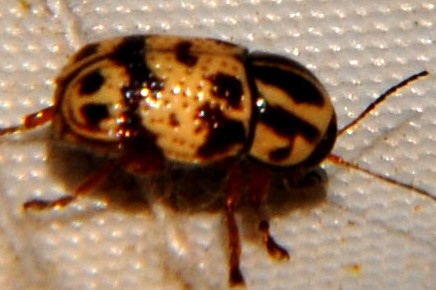Mesquite Casebearer Beetle
Cryptocephalus maccus

This beetle was found on new foliage of Velvet Mesquite (Prosopis velutina). The immature grub, which lives within a self-made case probably lives in the leaf litter below the tree. French Creek, Bradshaw Mts., Yavapai Co., Arizona. May 2009. Identification was provided by John Watts.
Chrysomelidae -- Leaf Beetle Family
Casebearers get their name from the immature grub stage which builds a hardened case made from fecal material. The soft-bodied grub is protected inside from desiccation and is camouflaged from predators by appearing as something quite inedible. Predacious ants also seem repelled by the case material. Each species of casebearer tends to specialize on one or a few plant species. However, because the larval stage is obscure, often feeding on the ground below the plant, entomologists may have difficulty in definitively linking beetle and host plant.
There are many species of casebearer leaf beetles found in the Sonoran Desert - up to 40 - most are attractively colored with intricate patterns on a shiny exoskeleton. From above, the head is nearly concealed by the pronotum - the Latin name, Cryptocephalus, means ‘hidden head’. They are most apparent as adults in the spring and again during the summer rainy season. Numbers vary greatly from year to year depending on rainfall. Most species are only a few millimeters in length.